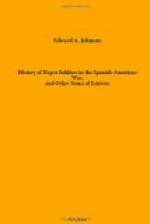ANOTHER EXILE.
Another beloved exile from the land of his birth is Senor Jose White. His mother was a colored woman of Matanzas. At the age of 16 Jose wrote a mass for the Matanzas orchestra and gave his first concert. With the proceeds he entered the Conservatory of Paris, and in the following year won the first prize as violinist among thirty-nine contestants. He soon gained an enviable reputation among the most celebrated European violinists, and, covered with honors, returned to Havana in January of ’75. But his songs were sometimes of liberty, and in June of the same year the Spanish government drove him out of the country. Then he went to Brazil, and is now President of the Conservatory of Music of Rio Janeiro.
One might go on multiplying similar incidents. Some of the most eminent doctors, lawyers and college professors in Cuba are more or less darkly “colored.” In the humble walks of life one finds them everywhere, as carpenters, masons, shoemakers and plumbers. In the few manufacturies of Cuba a large proportion of the workmen are Negroes especially in the cigar factories. In the tanneries of Pinar del Rio most of the workmen are colored, also in the saddle factories of Havana, Guanabacoa, Cardenas and other places. Although the insurgent army is not yet disbanded, the sugar-planters get plenty of help from their ranks by offering fair wages.—New York Sun.
FACTS ABOUT PORTO RICO TOLD IN SHORT PARAGRAPHS.
Porto Rico, the beautiful island which General Miles is taking under the American flag, has an area of 3,530 square miles. It is 107 miles in length and 37 miles across. It has a good telegraph line and a railroad only partially completed.
The population, which is not made up of so many Negroes and mulattoes as that of the neighboring islands, is about 900,000. Almost all of the inhabitants are Roman Catholics.
It is a mountainous island, and contains forty seven navigable streams. The roads are merely paths beaten down by cattle.
Exports in 1887 were valued at $10,181,291; imports, $10,198,006.
Gold, copper, salt, coal and iron abound.
The poorer classes live almost entirely on a variety of highland rice, which is easily cultivated, as it requires no flooding.
One of the principal industries is grazing. St. Thomas is the market for fresh meat.
Corn, tobacco, sugar, coffee, cotton and potatoes constitute the principal crops.
There are no snakes, no beasts of prey, no noxious birds nor insects in the island.
The trees and grass are always green.
Rats are the great foe of the crops.
The natives often live to be one hundred years old.
The most beautiful flower on the island is the ortegon, which has purple blossoms a yard long.
Hurricanes are frequent on the north coast and very destructive.
Mosquitoes art the pest of the island.




